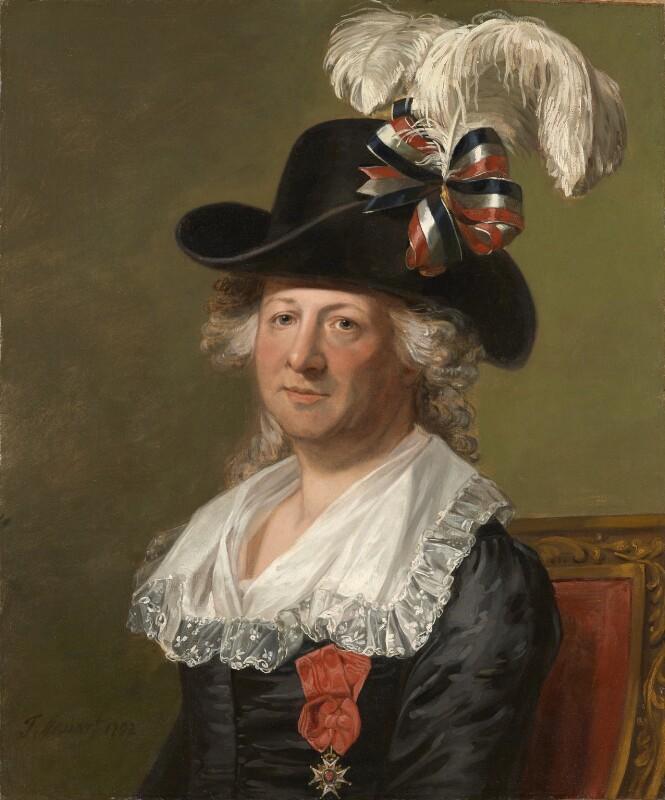Authored by: Angela Wachowich
Edited by: Michelle Levy and Kandice Sharren
Submitted on: 06/30/2021
Citation: Wachowich, Angela. "'Back in through the window:' The Chevalier/Chevalière D'Éon." The Women's Print History Project, 30 June 2021, https://womensprinthistoryproject.com/blog/post/78.
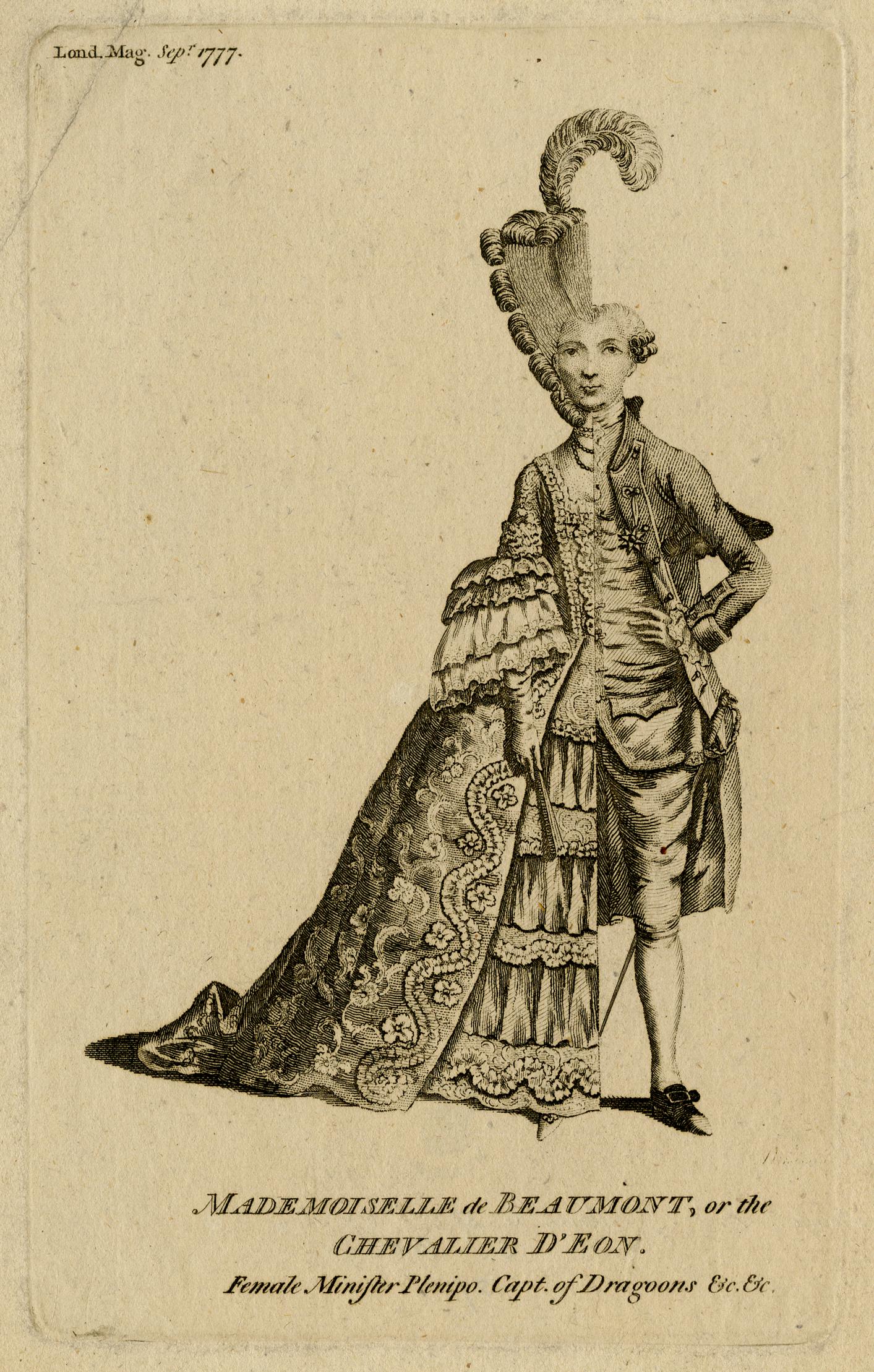
Figure 1. Mademoiselle de Beaumont, or the Chevalier D'Eon from London Magazine, print, 1772. British Museum.
The Women’s Print History Project was conceived with the intention of capturing women’s involvement in print. However, as editors of the project write in “Gendering Digital Bibliography,” a 2021 article in Eighteenth-Century Studies, databases like ours often
use a baseline assumption that the category of ‘woman’ is defined as subjects who were assigned female at birth or lived legibly feminine lives with she/her pronouns and feminized titles and honorifics … These unstated assumptions do not capture the richness, slipperiness, and playfulness of gender that eighteenth-century subjects performed. (90)
One of the people who has challenged us to change the gender binaries we originally used in our data model is Charles Geneviève Louis Auguste André Timothée d’Éon de Beaumont (1728–1810). D’Éon ostensibly lived the first forty-nine years of their life as a man, and the last thirty-two years of their life as a woman. It is in consideration of individuals like d’Éon that the WPHP now includes a transgender tag for persons. That said, data can only communicate so much, and as a project we hope to represent the more nuanced parts of gendered experience and identity in other venues, such as our Spotlights and The WPHP Monthly Mercury. This Spotlight is intended as an introduction to d’Éon and the act of reclaiming literary history with a trans-inclusive feminist perspective.
The scholarship surrounding d’Éon is largely and exhaustingly transphobic, and even the biography from which most of the information used in this Spotlight is drawn, Gary Kates’ Monsieur d’Éon is a Woman, insists on referring to d’Éon with he/him pronouns. Recently, however, Jesse Jack has presented us with a new way of reclaiming transgender literary history in the eighteenth-century following the approach suggested by Sandy Stone’s "The Empire Strikes Back: A Posttransexual Manifesto." Stone argues that “trans women retain the perspective of male privilege, yet that they also obtain the perspective of women’s oppression” and that it is therefore “a mistake to suggest that trans persons represent one category or another” (Jack 2). Instead, trans people represent “poli-vocalities from various gendered perspectives” (Jack 2). D’Éon was subject to the gendered experience of women’s oppression as well as male privilege, and as such, is one among many genderqueer and trans people who contribute a unique perspective to feminist literary history.
D’Éon embodies what Jack calls an intertextual genre of identity, rather than “a so-called third gender that exists antagonistically separate from a stable binary” (3). This intertextual perspective is especially apparent in d’Éon’s unpublished autobiography, where, as Emily Rose demonstrates, d’Éon oscillates between male and female gender markers. In d’Éon’s lifetime, they were referred to with both he/him and she/her pronouns, and Rose chooses to use ze/zir pronouns in relation to d'Éon. The use of they/them pronouns in this Spotlight, while neither used during the period of d’Éon’s life nor the norm in d’Éon scholarship, allows us to capture d’Éon’s gender identity with greater flexibility.
D’Éon was born on 2 October 1728 to a minor aristocratic family in Tonnerre, France. They excelled in school, graduating with a degree in law from the Collège Mazarin and contributing to a literary magazine in Paris before being appointed secretary to the French foreign minister in Russia. There, d’Éon was initiated into a top secret division of the French government called the King’s Secret, which had the intent of furthering France’s ends in Poland by improving relations between King Louis XV and Empress Elizabeth. D’Éon’s particular task was to courier messages between the King and Empress that no one else could know about. After about five years in Russia, d’Éon returned to France to fight in the Seven Years War, for which they were awarded the rare Cross of Saint Louis at the young age of thirty-five.
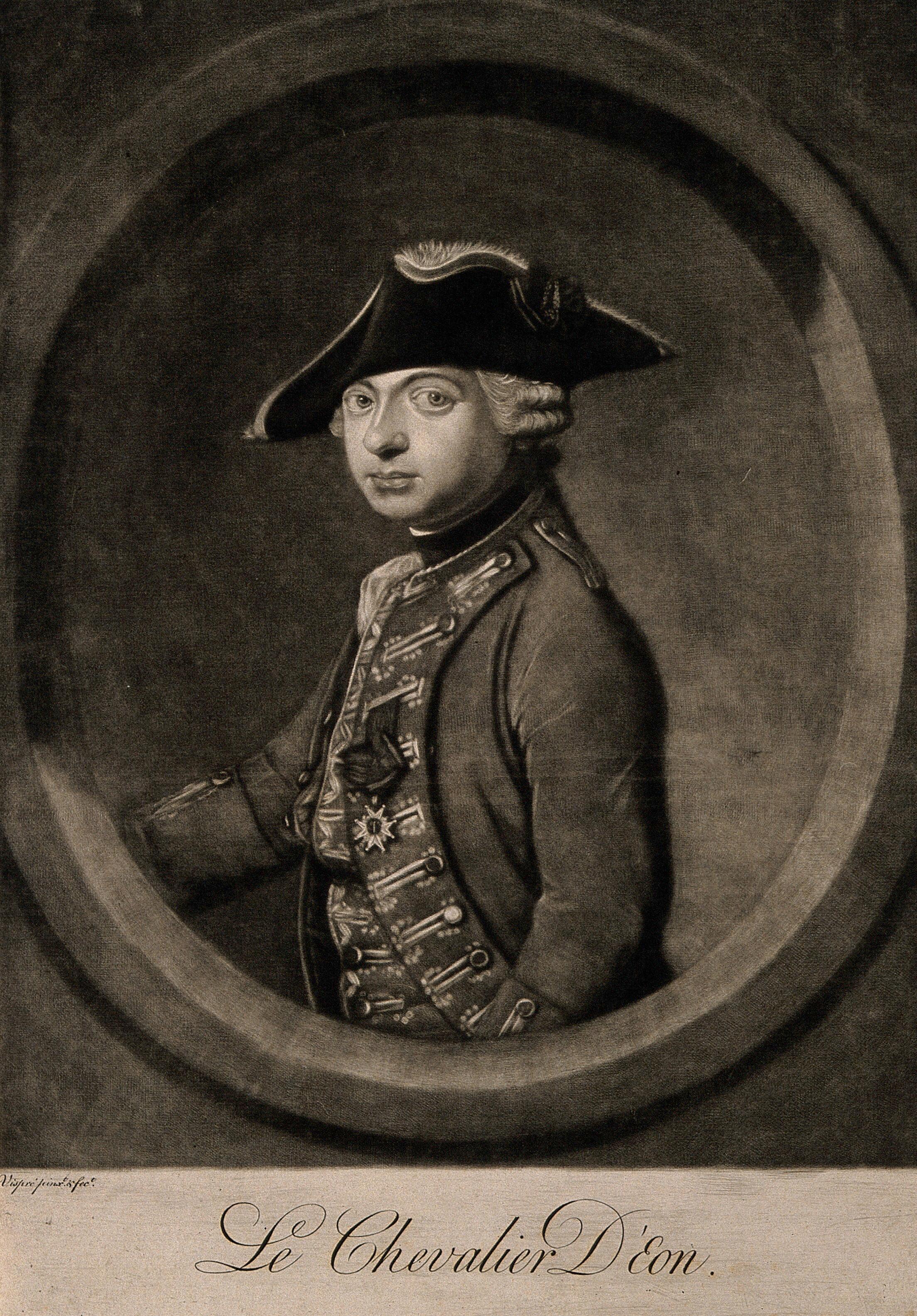
Figure 2. Le Chevalier D’Éon. Vispre pinxt. & fect by Victor Vispre or Francois Xavier Vispre, mezzotint.
D’Éon was sent to England as a peace delegate, helping to negotiate the end of the war and deliver the signed treaty in 1763. In England, they were appointed Plenipotentiary Minister or acting ambassador for France until a more permanent ambassador could be chosen. From this position, they were expected to support another member of the King’s Secret who was surreptitiously surveying British coasts for a possible site for a French invasion. D’Éon had in their possession letters from King Louis XV authorizing these efforts, which gave d’Éon a basis of power when they were asked to step down less than a year later. Their sudden fall-out with the French government seemingly had to do, in part, with d’Éon’s spending habits. For decades, the French government had encouraged its diplomats to practice a lifestyle that would help them keep powerful friends, such as aristocrats and politicians, who might prove useful to the French government in the future. D’Éon took this task rather seriously, going so far as to import enough French wine that the English prime minister threatened to impose tariffs and duties on them alone, from which diplomats were normally exempt. D’Éon asked their superiors for more money, but following the Seven Years War, France was impecunious. On 14 August 1763, they informed d’Éon that due to “financial constraints,” d’Éon was expected to step down to the position of Secretary to the Ambassador.
This demotion was, in part, a matter of routine, as d’Éon had only ever been appointed acting ambassador and a new, permanent ambassador was already on their way to London. But d’Éon, a proud and principled person, understood the step-down as a personal offense. As one of d’Éon’s friends put it, they could either protest and be reprimanded or quietly accept their new position—in their words, “This is the moment to choose between philosophy and politics” (qtd. in Kates 100). D’Éon chose philosophy, responding to their friend “I will always go my own way, fate has determined that; the bomb must burst; the fuse is at the end of the wick. Too bad for those who get splashed with mud or hit with pieces. Those with the most fear will pull back. The devil take me if I retreat” (qtd. in Kates 100).
D’Éon sent a series of angry letters to their superiors, and was consequently recalled to France to be fired. They refused to leave England, however, and exploited the confidential papers in their possession to delay and control the terms of their return. In mid-November 1763, another French diplomat in London wrote a pamphlet criticizing d’Éon, to which D’Éon responded with their own attack, Note remise a Son Excellence Claude, Louis, Francois, Regnier comte de Guerchy (1763). A year later, with negotiations for their return at a stand-still, d’Éon returned to the press with their most famous work, Lettres, mémoires & négociations particulière du Chevalier d’Éon (1764). Lettres, mémoires & négociations was a two-hundred-page documentary account of their recent history, reproducing secret diplomatic correspondence (though significantly nothing from King Louis XV). The book was intended as a threat to the French government should they continue to neglect d’Éon—it showed Louis that their threats to go public with information about the King’s Secret were serious, while holding on to the truly incriminating material. As Kates writes, “it is impossible to overstate the sensational reception this book received” (119). King George III could apparently talk of little else for days, and while copies were difficult to locate in France, all of Europe was abuzz. Despite the excitement, the French government continued to drag their feet in negotiating d’Éon’s return.
Around 1770, while d’Éon was still in London, rumours began to spread about their gender. Seemingly without explanation, people seemed to be perceiving d’Éon differently. These rumours ostensibly began among Anglo-French aristocrats—the first existing records of d’Éon being referred to as a woman are in the personal letters of, respectively, King Louis XV and Horace Walpole. It is generally accepted that the rumours were deliberately spread by d’Éon, who told friends ‘in confidence’ that they were a biological female raised as a male by their father, who had wanted a son. In 1771, British businessmen began to bet on d’Éon’s gender, and over the course of the next six years, hundreds of thousands of pounds were tied up in the stock market over the matter.
Negotiations for d’Éon’s return to France picked up again in 1775, following the death of King Louis XV. In May, when King Louis XVI took the throne and was informed of the King’s Secret and d’Éon’s part in the organization, Louis was appalled. He encouraged his representatives to negotiate with d’Éon for their immediate return and the return of the confidential documents. One of d’Éon’s conditions was that the French government recognize their female gender with a royal decree. By this time, the French government already considered them a woman disguised as a man and as such, they readily agreed. D’Éon returned to France in 1777.
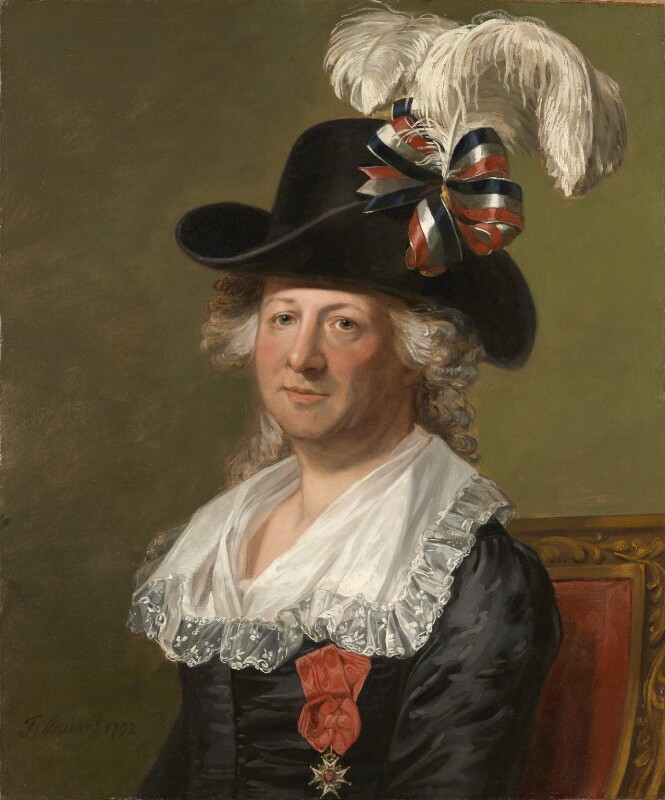
Figure 3. Chevalier D’Eon by Thomas Stewart, after Jean Laurent Mosnier, oil on canvas, 1792. NPG 6937.
From Kates’ perspective, d’Éon asked for the decree in order to secure their return to France with dignity and respect. Additionally, Kates argues becoming a woman was a method of moral purification for d’Éon, who sought to “actualize the virtuous aspects of his [their] personality repressed in a life of diplomacy and war” (195). While d’Éon’s conception of femininity was certainly connected to their Christianity, reducing their decision to a matter of political asylum is willfully ignorant. One of Kates’ main pieces of evidence that d’Éon transitioned for political reasons is that d’Éon resisted dressing in women’s clothing, adopting women’s garments in 1777 only because they were mandated to by the King. Upon this point, however, it is helpful to return to d’Eon’s own words on the subject:
I would prefer to keep my male clothes because they open all the doors to fortune, glory, and courage. Dresses close all those doors for me. Dresses only give me room to cry about the misery and servitude of women, and you know that I am crazy about liberty. But nature has come to oppose me, and to make me feel the need for women’s clothes, so that I can sleep, eat, and study in peace. I am constantly in fear of some sickness or accident that will, despite myself, allow my sex to be discovered … Nature makes a good friend but a bad enemy. If you chase it through the door, it just blows back in through the window. (qtd. in Kates 71)
Women’s clothing as described by d’Éon takes on the dual function of repressing and liberating them. It represents their “nature,” something they had hidden for want of “fortune, glory, and courage,” but that blew “back in through the window” regardless. In other words, gender can be performance, can be a matter of costume, but it is also something intangibly essential to our sense of personal identity, which it almost certainly was to d’Éon.
D’Éon’s new female wardrobe was designed by Rose Bertin, Marie-Antoinette’s wardrobe director. While they conceded to wearing women’s clothing for the rest of their life, they also insisted on continuing to wear the Cross of Saint-Louis on their breast, an ostensibly male military honour. As a consequence of d’Éon’s gender transition, they were expected to retire from political life. D’Éon, however, wanted to continue their career, and struggled to acclimatize to domestic life. In 1779 d’Éon’s friend, Peyraud de Beaussol de la Fortelle, published a biography of d’Éon called La Vie Militaire, Politique et Privée de Demoiselle Charles-Genevieve-Louise-Auguste-Andrée-Timothée Eon… D’Éon is suspected to have authorized and likely collaborated with Fortelle on the book. Even titularly, La Vie Militaire is a calibrated political and literary statement meant to represent d’Éon’s gender in tandem with their political achievements, particularly to the French elite who considered them mutually exclusive. In 1792, d’Éon rallied the French National Assembly to enlist them to lead an all-female division of soldiers, an offer that was unfortunately rebuffed.
In 1785, disappointed with their homeland, d’Éon moved back to England where they lived for the rest of their life, subsisting off of their diplomatic pension and the money they made at fencing displays. In some ways, religion took the place of politics, as d’Éon dedicated themself to becoming a model of female virtue. They considered themselves a Joan of Arc, and wrote prolifically about politics, gender, and religion, though they published none of it. D’Éon’s autobiography, drafted and sold, though it was neither finalized nor published, is one such text that exists only in manuscript, now held at Leeds Brotherton Library. When d’Éon died in London in 1810, their roommate of fourteen years, Mrs. Coles, prepared their body for presentation to visitors. Coles, an illiterate Christian woman who had bonded with d’Éon over their deep religious faith, was shocked to discover that d’Éon had the body of a biological male. When Mrs. Coles’ told her friends, they didn’t believe her. Absurdly, it took a group of ten to twelve people, multiple doctors, surgeons, professors, a lawyer and a journalist to inspect d’Éon's body and ascertain they had male anatomy.
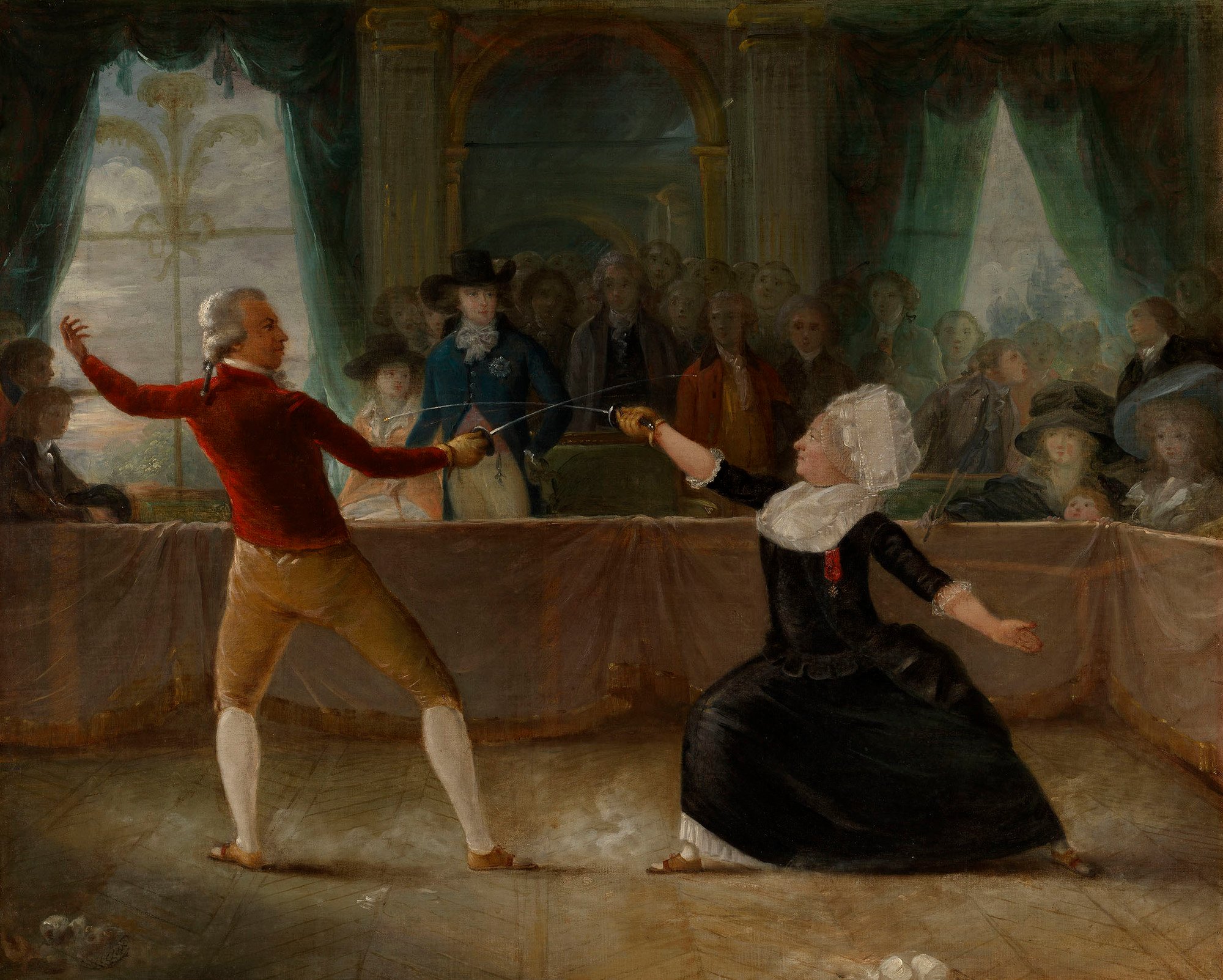
Figure 4. The Fencing-Match between the Chevalier de Saint-George and the Chevalier d'Eon by Alexandre-Auguste Robineau and Charles Jean Robineau, oil on canvas, ca. 1787–1789. RCIN 400636.
The recovery of d’Éon’s story is shrouded by misguided beliefs about their “real” body and the consequent use of he/him pronouns. To repurpose something that Jack writes about trans scholarship in general, perceiving figures like d’Éon as one gender or the other “inadvertently contribute[s] not only to the systemic erasure of authentically lived experiences for trans persons, but also to the perceived threat of trans-specific impersonation, deceit, and potential violence” (2). To view d’Éon as exclusively a man or a woman is to erase their lived experiences, and validate the perceived threat of their “real” body, as though they maliciously deceived and endangered those around them by transitioning. The role of feminist bibliographies like the WPHP in relation to figures like d’Éon, as well as Charlotte Charke, Mary Diana Dods, and others, is to celebrate their unique experiences and draw attention back to their own words so that they can speak for themselves.
WPHP Records Referenced
d'Éon de Beaumont, Charles Geneviève Louis Auguste André Timothée (person, author)
de la Fortelle, Peyraud de Beaussol (person, author)
Charke, Charlotte (person, author)
Dods, Mary Diana (person, author)
Walpole, Horace (person, author)
Works Cited
Jack, Jesse. “Reclaiming a Transgender History: The Intertextual Life of Charlotte Charke.” English: Journal of the English Association, vol. 70, no. 268, Spring 2021, pp. 47–65.
Kates, Gary. Monsieur d’Éon is a Woman: A Tale of Political Intrigue and Sexual Masquerade. John Hopkins UP, 2001.
Rose, Emily. “Keeping the Trans in Translation: Queering Early Modern Transgender Memoirs.” TSQ: Transgender Studies Quarterly, vol. 3, nos. 3–4, 2016, pp. 485–505.
Sharren, Kandice, Kate Ozment, and Michelle Levy. “Gendering Digital Bibliography with the Women’s Print History Project.” Eighteenth-Century Studies, vol. 54, no. 4, Summer 2021, pp. 887–908.
